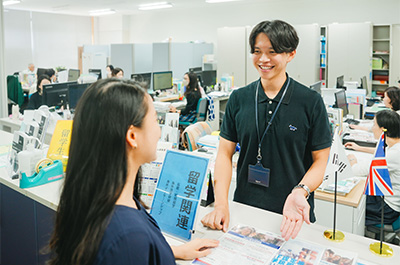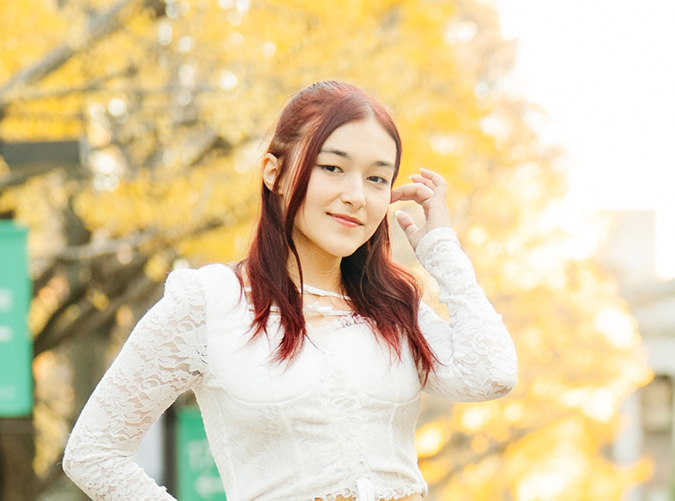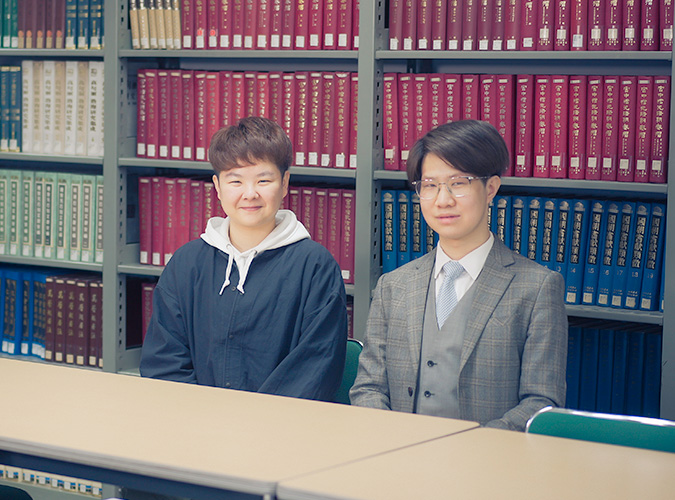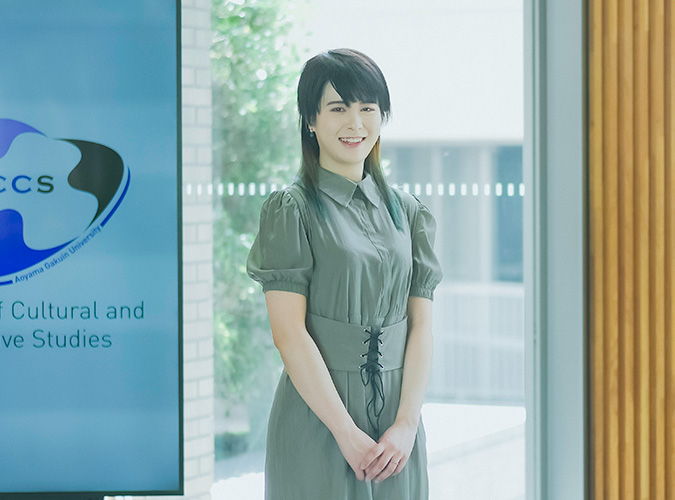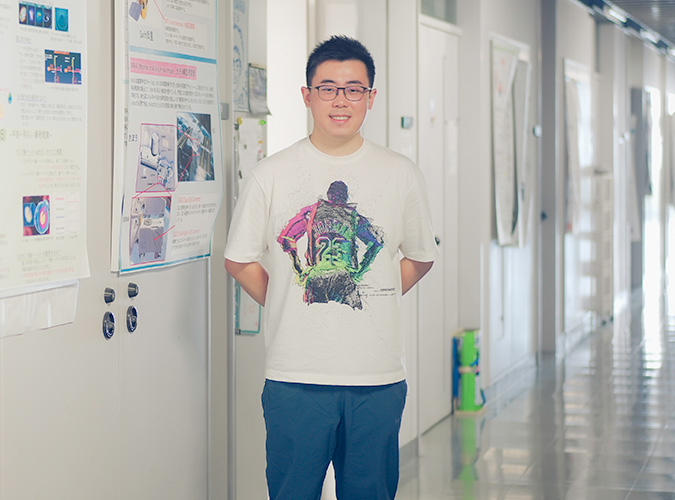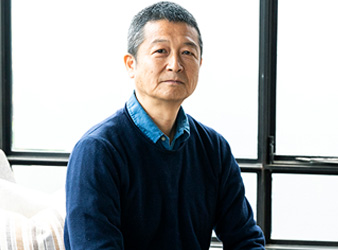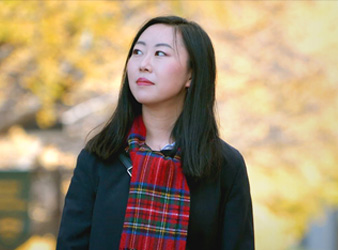Entrepreneurship, love, and a view of language discovered through the English translation of the“Man'yoshu”

OVERTURE
Arthur came to Aoyama Gakuin University(AGU)as an exchange student from the University of Washington in Seattle in 2013, and stayed for one year. He started an English education business in Japan, and currently has 311,000 subscribers on his YouTube channel “IU-Connect” (as of September 2023). With his adventurous spirit, he jumped into the world of Japanese literature and participated in a project to translate the “Man'yoshu” (one of the oldest collections of Japanese poetry in the world) into English. He shared his experience of studying “Japan” at AGU with us in fluent Japanese.
Balancing entrepreneurship and school life at AGU
When I was 11 years old, I was obsessed with “DRAGON BALL” and “Pokémon”. But I had no idea they were Japanese until a friend told me. That was the start of my interest in Japan. I had a dream of becoming a manga artist and started learning Japanese with a local Japanese exchange student when I was 13 years old.
But slowly, I became less and less interested in manga. Instead, my interests turned to the traditional art of Ukiyo-e and wood block printing. I felt like the spirit of Japan was reflected in these works of art, and I wanted to learn Japanese even more. That’s why I chose to go to University of Washington, a school where hundreds of Japanese exchange students come each year.
While in school, I started a volunteer project selling hats made by poor Romani women from Romania in order to help them make a living, but in 2013 I had the opportunity to study abroad at AGU and had to change my line of work. That’s when I decided to start my own business teaching English. I studied Japanese the way most Japanese people study English: focusing on grammar and vocabulary. But when I did a homestay in Japan and came face to face with Japanese people in real life my mind went blank. As I taught English in Japan, I felt more and more strongly that I wanted to change the English education industry in Japan. To do that, I started IU-Connect with the mission to help Japanese people connect with people from all over the world through English and live happy, fulfilling lives.
 Arthur's belief about English education is that it should nurture the ability to communicate images as well as the essential qualities of things to others.
Arthur's belief about English education is that it should nurture the ability to communicate images as well as the essential qualities of things to others.
For me AGU wasn’t just a place to experience student exchange, but a place to experience running a business. My first YouTube video was taken at AGU. I focused too much on my work and was habitually late to class. I can still hear the voice of one of my teachers ringing in my ears: “Arthur! Try to focus on class a little, ok?”
When my exchange ended in 2014 I went back to the USA for about a year and a half. But I came back to Japan to marry my wife, whom I met at AGU. Now I run my business with the goal of helping more and more people become connectors: people who don’t just study English but use it as a tool to get out into the real world and connect with people from all over the world. Helping other people has been a really important value of mine since even before studying abroad. Currently, I’ve published an English learning book, but I spend most of my time on my YouTube channel, online membership community, podcast, and one on one coaching.
 His wife, Natsumi, whom he met at AGU, is a graduate of the Department of English.
His wife, Natsumi, whom he met at AGU, is a graduate of the Department of English.
Why I chose AGU: “I could take the same classes as regular students”
The main reason why I chose AGU was because I could take the same classes as regular students. Most of the exchange programs from the University of Washington had exchange students taking special courses for exchange students; the class choice was really limited. The AGU exchange program was really flexible, allowing me to pick any class that piqued my interest. The freedom was really appealing to me. One of the reasons I was able to focus on both work and school was because of the flexibility of the curriculum.
Of course, taking classes in Japanese was very difficult. I really felt that in my “History of Japanese thought” class. In that class we looked at the differences between Japanese and other Indian/Southeast Asian Buddhism, Christianity, and Shinto. It was a class where we really dove deeply into Japanese thought, but words that are second nature to Japanese people like “Ojizosama” and “Hotokesama” were words that I had never heard before. The special terminology and Kanji was really tough, too. To be honest, I was a bit over my head and understood hardly anything. But as I reviewed my notes I started to understand slowly. At the end of the last class I worked up the courage to talk to my professor. The conversation we had about the similarities between Buddhism and Christianity is something I remember even to this day.
The life-long connections built at AGU
Another great thing about AGU is that you can enjoy Tokyo to its fullest. Lots of foreigners think of Shibuya when they think of Tokyo, and the Shibuya Scramble Crossing is right by the school. You’re also really close to Meiji jingu and the back streets of Omotesando, full of hole-in-the-walls to your hearts content. It’s a university where you don’t just study, but also really feel the uniqueness of Japan.
There weren’t many classes you could take in English when I went there, but I’ve heard there’s quite a few now. AGU is the school you want to go to if you want to make the most of your options for study.
I myself am pretty adventurous and wanted to stand on my own two feet, so I didn’t use the housing resources the university provided when I came here - I did everything myself. When it comes to the international exchange on campus, I automatically think of my wife Natsumi who was part of the Department of English here. I also became really good friends with Mr. Shunsuke Yamada (from the Department of Economics), who was my assigned tutor and support. He knew tons of great places around campus, he helped me with my YouTube filming and we had a great time. Through that, he also wanted to focus on entrepreneurship. After he graduated, he told me “Arthur, you inspired me to start my own business. I moved to San Francisco!” He is in America; I am in Japan. AGU brought us to where we are today, two people starting businesses in a foreign land.
 In Asakusa with Shunsuke Yamada, who was involved in supporting international students.
In Asakusa with Shunsuke Yamada, who was involved in supporting international students.
What translating the “Man'yoshu” taught me about conveying images through words.
A big challenge while I was at AGU was creating English translations of the “Man'yoshu” when I joined Professor Komatsu Yasuhiko’s “Japanese Literature Seminar.” When I heard of Prof. Komatsu’s request for help on this project, the only thing I knew about the “Man'yoshu” was that it was a book of pretty old poems. I thought that it would be too difficult for me, but I may as well just give it a chance. I had majored in linguistics and Japanese language in school and wanted a challenge. More than getting credits, I was focused on doing meaningful work.
After only a few minutes of joining the class for the first time Prof. Komatsu already started asking me “How would you say this in English?” To be honest I was pretty lost. The “Man'yoshu” is difficult even for Japanese people - it was that much more difficult for me. In the beginning I focused on translating the text word by word, trying to keep the meaning intact. But when I tried to translate particularly difficult passages, it just came out too direct, too weird. It was around that time I realized that meaning isn’t about words; it’s about images and feelings, so I started to translate more loosely. Instead of putting importance on each word, I focused on the image, the essence, and how to translate that. The class was so stimulating for me I never missed a single class.
How my “Man'yoshu” translation work affected my teaching style.
Both English and Japanese are two sides of the same tool; they are both tools for communication. To communicate is to share an image or feeling (what I call “messages”) with others. It’s not about translating words into another language. It’s the same for English and Japanese.
Actually, when Japanese people study English, too, it’s really important to focus on the image or the essence, not the words themselves (just like with the “Man'yoshu”). In all my YouTube videos I always hit home the point that English isn’t about translating Japanese words in English. It’s about sharing images and feelings. This idea that was born out of Prof. Komatsu’s class has been burned deep into my subconscious.

On the outside, we use different languages like Japanese or English to express ourselves, but on the inside we all have the same desires and dreams. At the root of it all, we are all the same: human. I hope that my students develop this image-based communication ability and feel this truth deep within them. I’ll continue doing my best to help many people become connectors, people who connect with people from all over the world and can share the richness of Japan with them.
A conversation between Prof. Komatsu Yasuhiko and Arthur
Discovering a truly “international” way to read the “Man’yoshu” with Arthur
The class that Arthur attended in 2013 was my “Seminar in Japanese Literature.” It’s a class that normally only Japanese literature majors can attend. At that time, students would read English translation of “Old Japanese Poems,” try to make their own English translations, and try to see Japanese literature and culture from a new point of view. That was the purpose of the class. So I knew that having an exchange student as a guest attendee would make for a great class for the students. When I asked for volunteers, Arthur was the only one who offered to join.
Arthur worked on translations every week just like the other Japanese students, but he had a deep understanding of the matter. He also, when looking at my translations, directly shared his opinion, saying “that doesn’t sound natural” at times.
Arthur says he learned how to translate by focusing on image in my class, but actually I feel like that’s something he taught me. Until that time whenever I had a part that was difficult for foreigners to read and understand, like when there was a uniquely Japanese, ambiguous expression, I tried to make an explanatory translation.
It’s like what he calls “direct translation” but even more directly explanatory than that. When I’d share those translations with Arthur, he’d say “No no, you don’t need to explain it. It already makes sense.” I realized that the “Man’yoshu” isn’t something that only Japanese people can understand. It’s a part of the universal discussion we are all having. What does it mean to be human? What does it mean to live?
Since then, I’ve focused more on image-based translation and my English translations have become a lot shorter. Arthur was a student, but at the same time he was like a teacher to me. I would love to one day compose an English translation of the “Man’yoshu” with Arthur one day. I already have some poems ready.
One of the “Man’yoshu” Poems that Arthur Translated
瓜食(は)めば 子ども思ほゆ 栗食(は)めば まして偲(しの)はゆ いづくより 来たりしものそ まなかひに もとなかかりて 安眠(やすい)しなさぬ (山上憶良、萬葉集巻5・802)
〔Prof. Komatsu’s translation〕
When I eat melon,
My children come to my mind.
When I eat chestnuts,
They are on my heart.
Whence have they come to see me?
Their images keep flitting so excessively
As to take me away peaceful sleep.
(Yamanoue no Okura, Book 5: 802 )
▼Arthur‘s translation from 10 years ago.
Eating melons
The children come to mind
Eating chestnuts
The longing is even stronger
Where do they come from
Their images, haunting
Keeping their father from slumber
Komatsu-sensei! You chose this poem! I’m so glad! This is the poem that I remember the most. What a surprise! But now that I read it, there is a part that still leaves me wanting a bit – haha. I would translate this poem like so.
If I eat melons,
I think of my children.
If I eat chestnuts,
I long for them even more.
Where did they come from?
Their images flashing here and there.
Keeping me from sleep
As for me, I’m always thinking of my two boys. Taking care of children is really tough.
And now, Yamanoue no Okura’s poem hits me like a ton of bricks. It’s natural to want to take care of your kids and keep them in your heart and mind, but sometimes you can’t even just catch a breath. Still, I wouldn’t trade this life for anything. Looking after my kids, helping my kids grow up is a great joy to me.
This poem is a set with another famous poem in the “Man'yoshu” to form a longer poem (Book 5: 803 ).
銀(しろかね)も 金(くがね)も玉も なにせむに 優(まさ)れる宝 子(こ)に及かめやも
〔Prof. Komatsu’s translation〕
Surely,
Even silver, gold and jewels
Are inferior to
The greatest treasure,
Children.
This full poem focuses on how natural it is to think about your children, using the rhythm to convey that feeling. Arthur’s translation from ten years ago as well as his current one, both have that “rhythm” in it. But in the poem from 10 years ago, the first part and the fourth part, the “children” and “passion”, are subjects leading the expression of thinking of your kids to be more passive (this is a more direct translation of the original text).
But in the newer translation, the subject has become “I”, the singer, and has become more active. Also, the newer translation uses the phrase “flashing here and there,” which gives an image of the children moving vividly. This is a translation that really conveys the passion that Arthur has for his kids. I would love for him to recite it someday.
Aoyama Gakuin International Center
The role of the International Center (IC) at Aoyama Gakuin University is to provide educational support related to the internationalization of the university as well as to support the development of students to become global citizens. The main work of the IC consists of assisting both students going overseas and international students from overseas partner schools and approved institutions; as well as planning and operating intensive language training along with other programs and special events. The worldwide trend of globalization affects not only corporate activities and international relations, but should also impact the structure of university education and curricular content. With that in mind, the IC strives to strengthen and expand collaboration between overseas universities and Aoyama Gakuin University while respecting the diverse cultures and traditions of each country as well as the customs and values of our students.
